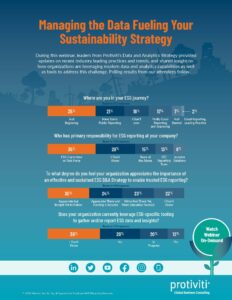The first formal mention of environmental, social and governance (ESG) principles appeared some 18 years ago in the United Nations’ Global Compact initiative, which garnered support from financial institutions across the world. During the next decade-and-a-half, and without much notice, ESG slowly gained steam. But outcries to address climate change in recent years, as well as social and gender inequality issues coming to the forefront, have supercharged ESG’s momentum, thrusting the concept into the mainstream. The ESG position of a company has now become a key criteria for investors, backed by a rapidly hardening sustainability disclosure regulatory environment.
 That is to say, ESG is here to stay. When initiating or reviewing a business relationship with a company, everyone – from institutional investors, lenders and insurers, to customers and employees, including prospective employees – increasingly wants to hear that organization’s ESG story. For regulators, that story should also form the basis for formal disclosure of ESG information. Just this week, the European Council approved the adoption of a sweeping new mandatory disclosure law – the Corporate Sustainability Reporting Directive. In the U.S., the SEC is expected to finalize its final climate disclosure rules shortly – likely during the first quarter in 2023.
That is to say, ESG is here to stay. When initiating or reviewing a business relationship with a company, everyone – from institutional investors, lenders and insurers, to customers and employees, including prospective employees – increasingly wants to hear that organization’s ESG story. For regulators, that story should also form the basis for formal disclosure of ESG information. Just this week, the European Council approved the adoption of a sweeping new mandatory disclosure law – the Corporate Sustainability Reporting Directive. In the U.S., the SEC is expected to finalize its final climate disclosure rules shortly – likely during the first quarter in 2023.
Amid these new demands, an organization’s ability to gather data to tell its ESG story is becoming paramount to its growth, operations and even credit rating. While the stories will vary with an organization’s individual circumstance and industry – an energy company’s tale will be much different from that of a professional services firm – the data backing these stories must be accurate, trusted and verifiable.
What’s Your Story?
While traditional reporting focuses on revenue, expenses, assets, liabilities and other financial metrics, ESG reporting takes into account greenhouse gas emissions, energy and water usage, system breaches and workforce diversity, to name just a few topics. In order to tell their story in a compelling, effective and verifiable manner, organizations need to apply foundational data management methods to ESG, similar to any other reporting and analysis use case. The following five steps can help organizations formulate their ESG data strategy.
Step 1: Decide What Story to Tell
To many organizations, telling an effective ESG story requires balancing offense and defense – meaning they must decide where their reporting obligations end and opportunity to position as a sustainability leader begins. They must decide who their most important audience is – is it investors, customers or regulators? For example, oil and gas companies provide a necessary service that nevertheless is inherently ESG challenged, and they may feel burdened by ESG regulatory compliance and public backlash. But by making their required disclosures and by going further – by demonstrating a commitment to remediation or renewable investments – they can tell a story that is more than what’s expected or considered typical for their industry. Similarly, an apparel brand may attract a wider base of customers by telling a story of commitment to sustainable materials and fair labor practices.
Step 2: What story CAN you tell?
Once an organization determines its story, it needs the data to back it up. Companies should assess what ESG data they already possess and exercise the same data management discipline as they do in other reporting functions to ensure the quality of the data – in other words, it needs to be auditable data. Data Whisperer Scott Taylor notes, “Good decisions made on bad data are just bad decisions you don’t know about yet.” To paraphrase this saying, a good story cannot be told using bad data; savvy audiences – including regulators and investors – will react quickly, and lost credibility will be very difficult to regain. Needless to say, authenticity and adherence to values are of vital importance. Few have a perfect narrative to share. Every organization faces challenges and makes mistakes. It is just as well to treat the ESG storyline in a manner consistent with what it represents – management’s communication of progress along a continuous journey.
Step 3: Keep it Simple
Typically, the system architecture that companies already have in place – enterprise resource planning, customer relationship management, general ledger and human resource systems – can be tailored to capture ESG information. On a very basic level, companies can utilize the data in these systems to produce information on how much waste they send to a landfill versus how much they recycle, their energy or water consumption, and their employee and supplier diversity numbers, among other ESG-relevant metrics.
Step 4: Establish Vendor Relationships
By establishing what data they can produce themselves, organizations are better suited to sift through the dozens of vendor options available to fill gaps on specific ESG topics. Some reporting solutions specialize in supporting ESG disclosures, and major cloud operators have extended their modules and capabilities to serve the space. Additionally, it’s advisable to lean on academic research institutions and other marketplace service vendors that are exchanging information with specific industries. Among other benefits, the knowledge base these vendors are building can help organizations calculate their carbon emissions, water usage and other ESG reporting metrics that may be difficult to precisely measure on their own.
Step 5: Be Flexible
ESG reporting is still in its early stages for most companies, but now is the time for organizations to bolster their data and analysis capabilities that will support it. Reviewing the disclosures of peers within the same industry, tracking regulatory developments, which are moving quickly, and remaining nimble enough to pivot to new innovative data models are keys to building a strong and uniform ESG reporting platform. When assessing ESG vendors, for example, companies should look for the ability to add or subtract them at will. That’s because as ESG reporting expectations evolve, the potential for vendor failures and consolidation will increase.
Change is the only constant in business. Just like the early days of every other regulatory regime, ESG reporting is a shifting landscape. By creating a compelling ESG narrative based on available and obtainable data, organizations can continue to have confident conversations with their stakeholders in the new sustainability paradigm.
To learn more on this topic, listen to our on-demand webinar, Managing the Data Fueling Your Sustainability Strategy.






